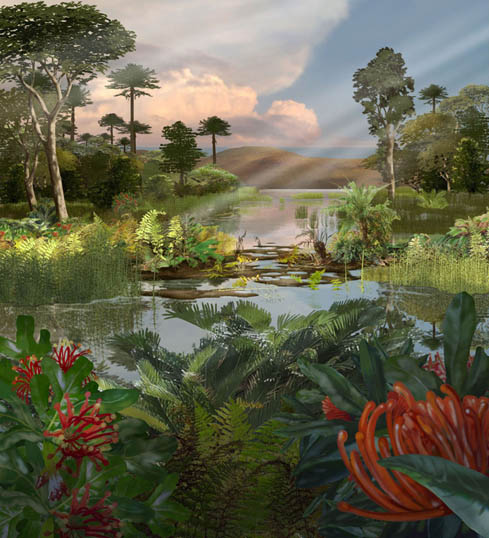I was reading this article about the recently released study on ancient Arctic climate. It is a very interesting article well worth the read, but the pertinent information is contained in these paragraphs (emphasis mine):
Based on reconstructions of Arctic climate variability in the greenhouse world of the Late Cretaceous, Southampton scientists have concluded that man-made global warming probably would not greatly change the climatic influence associated with natural modes of inter-annual climate variability such as the El Niño—Southern Oscillation (ENSO) or the Arctic Oscillation/ North Atlantic Oscillation (AO/ NAO).The first thing that came to mind was this from AR-4 Synthesis Report
"Even in the warm Cretaceous period, the patterns of these climatic oscillations changed over longer decadal timescales," explained Professor Alan Kemp of the University of Southampton's School of Ocean and Earth Science based at the National Oceanography Centre, Southampton. "It is therefore difficult to predict whether anthropogenically driven warming will lead to systematic changes such as persistently milder European winters (a positive AO/ NAO) as some have suggested."
EuropeWhat I found interesting was the Late Cretaceous period which the researchers of the new study used to compare the coming climate Apocalypse to was not exactly known for its lack of bio-diversity.
*Climate change is expected to magnify regional differences in Europe’s natural resources and assets. Negative impacts will include increased risk of inland flash floods and more frequent coastal flooding and increased erosion (due to storminess and sea level rise).
*Mountainous areas will face glacier retreat, reduced snow cover and winter tourism, and extensive species losses (in some areas up to 60% under high emissions scenarios by 2080).
*In southern Europe, climate change is projected to worsen conditions (high temperatures and drought) in a region already vulnerable to climate variability, and to reduce water availability, hydropower potential, summer tourism and, in general, crop productivity.
*Climate change is also projected to increase the health risks due to heat waves and the frequency of wildfires.
Dramatic changes occurred in plant life during the Cretaceous. Pollinating insects such as bees and butterflies allowed the emerging flowering plants—the angiosperms —an advantage over seed-bearing plants that relied on the wind or a chance encounter with an animal to disperse their seeds. Today, nearly 90 percent of plants on Earth are angiosperms, signifying a remarkable evolutionary success story. Forests of oak and willow, cypress, magnolia, palms, and sycamore slowly replaced the cycad forests—palm-like plants with a barrel shaped trunk and many long leaves growing from the top. These new plant communities provided new sources of food and habitat for many kinds of animals.Interesting isn't it that the very climate they are projecting for the future is the climate that allowed us to have the plant life we now enjoy. Which also begs the question, if our biosphere is so sensitive to climate change, why is it that all these plant species that evolved during a time when it is warmer than it is now and which they compare our future to, survived the cooler climate that the warmist seem to believe is the natural order? If "forests of oak and willow, cypress, magnolia, palms, and sycamore" evolved and thrived due to pollinating insects which also evolved during this warmer period how bad could it have been? Or more importantly, how bad will it be when we return to the past? If that is our unfortunate (?) fate.
During the Cretaceous, the dinosaurs reached the height of their evolutionary success....
But I digress.
What caught my attention in the article was this line "It is therefore difficult to predict whether anthropogenically driven warming will lead to systematic changes such as persistently milder European winters (a positive AO/ NAO) as some have suggested." Well who suggested it?
Among others where's the heat Kevin Trenberth of NCAR in this article from 1997
As a record El Niño event changes temperature and precipitation patterns over a large part of the globe, it's natural to ask whether these changes have anything to do with the warming air and changing precipitation caused by human beings. According to Kevin Trenberth (NCAR Climate and Global Dynamics Division, or CGD), the answer is a likely yes--with emphasis on the "likely." But the link is quite complicated, and some questions remain unansweredWell it appears that "likely" is not likely at all. Like almost everything to do with climate science in the alarmist epoch, theories are advanced as "likely" with much fanfare and alarm, building a psychological Mountain of Doom in society. Later when the "likely" is diproven it hardly matters since the
Some may say that they do not do this intentionally to deceive the pubic, that new research has proven that their original analysis wrong. A point which I would gladly grant had not this swamp of unscrupulous vipers not proven by their actions again and again that they will hide and distort their own research in order to maintain the theory, else why would it take leaked Emails to learn the truth of their own doubts :
...The fact is that we can’t account for the lack of warming at the moment and it is a travesty that we can’t. The CERES data published in the August BAMS 09 supplement on 2008 shows there should be even more warming: but the data are surely wrong. Our observing system is inadequate...Kevin Trenberth
How many of these "likely" predictions must be proven wrong before these scientist begin to shoot straight with the public? I would say about as likely as they will explain that if a warmer Arctic causes a colder Northern Hemisphere how did the Dinosaurs roam in Canada- "not likely".

No comments:
Post a Comment